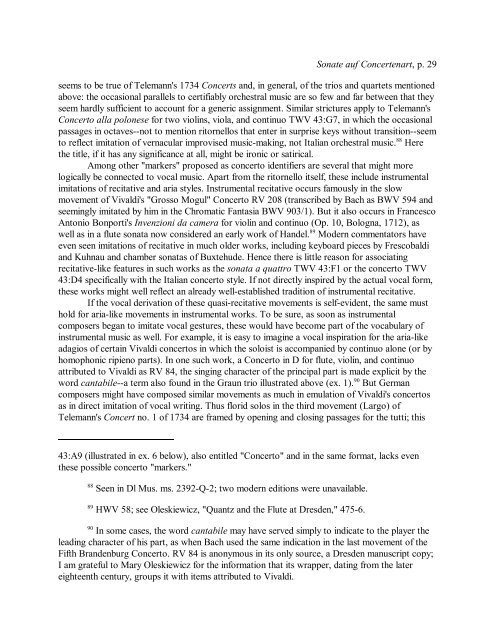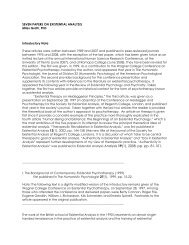The Sonate auf Concertenart: A Postmodern Invention? David ...
The Sonate auf Concertenart: A Postmodern Invention? David ...
The Sonate auf Concertenart: A Postmodern Invention? David ...
You also want an ePaper? Increase the reach of your titles
YUMPU automatically turns print PDFs into web optimized ePapers that Google loves.
<strong>Sonate</strong> <strong>auf</strong> <strong>Concertenart</strong>, p. 29<br />
seems to be true of Telemann's 1734 Concerts and, in general, of the trios and quartets mentioned<br />
above: the occasional parallels to certifiably orchestral music are so few and far between that they<br />
seem hardly sufficient to account for a generic assignment. Similar strictures apply to Telemann's<br />
Concerto alla polonese for two violins, viola, and continuo TWV 43:G7, in which the occasional<br />
passages in octaves--not to mention ritornellos that enter in surprise keys without transition--seem<br />
88<br />
to reflect imitation of vernacular improvised music-making, not Italian orchestral music. Here<br />
the title, if it has any significance at all, might be ironic or satirical.<br />
Among other "markers" proposed as concerto identifiers are several that might more<br />
logically be connected to vocal music. Apart from the ritornello itself, these include instrumental<br />
imitations of recitative and aria styles. Instrumental recitative occurs famously in the slow<br />
movement of Vivaldi's "Grosso Mogul" Concerto RV 208 (transcribed by Bach as BWV 594 and<br />
seemingly imitated by him in the Chromatic Fantasia BWV 903/1). But it also occurs in Francesco<br />
Antonio Bonporti's Invenzioni da camera for violin and continuo (Op. 10, Bologna, 1712), as<br />
89<br />
well as in a flute sonata now considered an early work of Handel. Modern commentators have<br />
even seen imitations of recitative in much older works, including keyboard pieces by Frescobaldi<br />
and Kuhnau and chamber sonatas of Buxtehude. Hence there is little reason for associating<br />
recitative-like features in such works as the sonata a quattro TWV 43:F1 or the concerto TWV<br />
43:D4 specifically with the Italian concerto style. If not directly inspired by the actual vocal form,<br />
these works might well reflect an already well-established tradition of instrumental recitative.<br />
If the vocal derivation of these quasi-recitative movements is self-evident, the same must<br />
hold for aria-like movements in instrumental works. To be sure, as soon as instrumental<br />
composers began to imitate vocal gestures, these would have become part of the vocabulary of<br />
instrumental music as well. For example, it is easy to imagine a vocal inspiration for the aria-like<br />
adagios of certain Vivaldi concertos in which the soloist is accompanied by continuo alone (or by<br />
homophonic ripieno parts). In one such work, a Concerto in D for flute, violin, and continuo<br />
attributed to Vivaldi as RV 84, the singing character of the principal part is made explicit by the<br />
90<br />
word cantabile--a term also found in the Graun trio illustrated above (ex. 1). But German<br />
composers might have composed similar movements as much in emulation of Vivaldi's concertos<br />
as in direct imitation of vocal writing. Thus florid solos in the third movement (Largo) of<br />
Telemann's Concert no. 1 of 1734 are framed by opening and closing passages for the tutti; this<br />
43:A9 (illustrated in ex. 6 below), also entitled "Concerto" and in the same format, lacks even<br />
these possible concerto "markers."<br />
88<br />
89<br />
Seen in Dl Mus. ms. 2392-Q-2; two modern editions were unavailable.<br />
HWV 58; see Oleskiewicz, "Quantz and the Flute at Dresden," 475-6.<br />
90<br />
In some cases, the word cantabile may have served simply to indicate to the player the<br />
leading character of his part, as when Bach used the same indication in the last movement of the<br />
Fifth Brandenburg Concerto. RV 84 is anonymous in its only source, a Dresden manuscript copy;<br />
I am grateful to Mary Oleskiewicz for the information that its wrapper, dating from the later<br />
eighteenth century, groups it with items attributed to Vivaldi.















